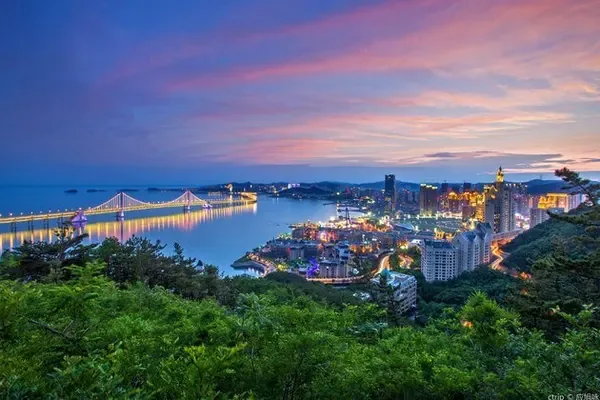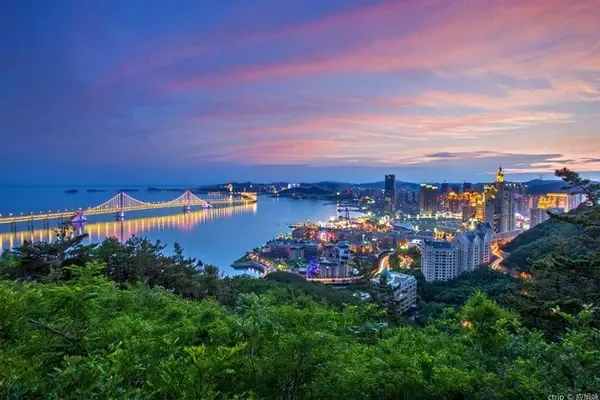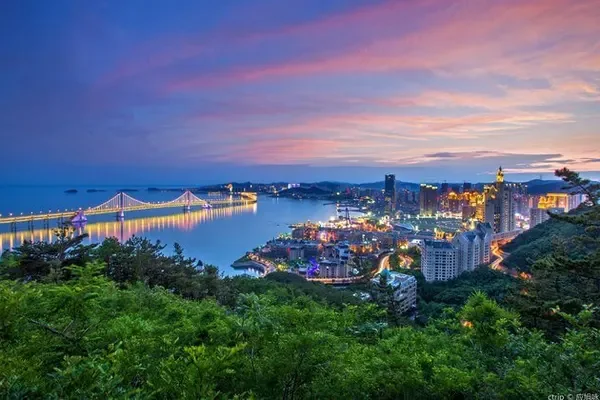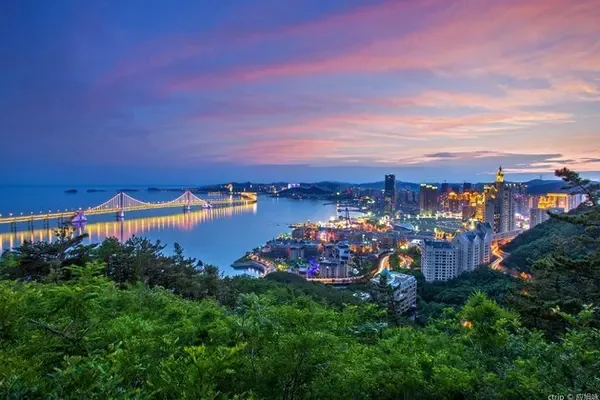There are actually many small and interesting places around Beijing, which are suitable for short-term holiday travel and weekend trips. These scenic spots have valleys, strange rocks, creeks, and forests, which almost meet the needs of everyone looking for a "summer resort" for summer travel. In addition to escaping the summer heat, it also has endless fun such as inhaling oxygen to filter the lungs, raising forests, exploring the jungle, and finding rare plants. These leisure and wild interests have naturally become the travel preferences of some people, and they regard this small and interesting mountain forest as a treasure, and rank it as the first resort for themselves and their families.


There are several places like this in Xinglong County, Hebei Province. In addition to Wuling Mountain, which is the favorite of photographers, Kistler Valley and other niche tourist destinations are also amazingly beautiful.
Wuling Mountain: Immortal Mountain and Sea of Clouds
Wuling Mountain, the origin of its name, is because the clouds and mists in the valley have aura.


Therefore, if you want to come to Wuling Mountain to see the scenery, in addition to enjoying the mountain scenery and shouting at the top to see the small mountains, the most important scenery is to watch the sunset and sunrise of the sea of clouds.



Here, after a sudden heavy rain, layers of mist rise from the mountain, permeating the ridge, dancing in changing appearances. When standing on the top of the mountain overlooking, it seems that you are in the place where the immortals are cultivating immortals. Or the carefree feeling of flying through the clouds and fog.



The clouds and mists of Wuling Mountain, sunrise and sunset, and even the Buddha's light, which are very easy to appear, are the natural scenery subjects that are deeply loved by photographers.


If there is good weather or good luck, the beautiful scenery of Wuling Mountain will appear. Waiting at the top of the mountain is the most suitable place to watch the morning glow and sunset, and you can create a beautiful landscape with just one shot. As the brightest mountain in Yanshan, its story will add a lot of mystery to its scenery.

Wuling Mountain is the upper wind and upper water of Qingdong Mausoleum. Since the majestic appearance of Wuling Mountain, there have been a steady stream of stories about it being able to be dug deep. Starting from the discovery of human activities in the late Paleolithic period in Sifang Cave under Wuling Mountain, "Sifang Cave Man "Only 20,000 to 30,000 years ago, the Paleolithic culture was created; from the Emperor Ku's era of worshiping swallows and changing "Yanshan" to "Yanshan" in the "destiny mysterious bird, descended to give birth to business", to the Yan State in the Spring and Autumn Period and Warring States Period As a result, the "Xiyan, Nanyan, Beiyan, Qianyan, and Houyan" that appeared successively in the Five Hu and Sixteen Kingdoms embody Yanshan culture everywhere; starting from the ruins of the Shanrong people, to the East Lake people, Xianbei people, Xi Nomads such as the Rouran people, Khitan, Jurchen, Mongolian and other nomadic peoples alternately separatist regimes, which embody the national culture of Wuling Mountain everywhere; From the beginning of the construction of the Great Wall during the Northern Qi Dynasty in the turmoil of the Southern and Northern Dynasties, to the breach of the Great Wall of more than 12,700 miles in the Ming Dynasty, Wuling Mountain shows the heavy Great Wall culture; from the cliff carvings in Wuling Mountain in the Ming Dynasty, we can read The inscription culture of drums and horns contending; the Qinghuangling culture of landscape and geography can be read from the Fengshui forbidden area of Houlong and Taizu Mountain in the Eastern Tomb of Qing Dynasty.

Standing on the main peak of Wuling Mountain, you can have a panoramic view of Miyun Reservoir, Simatai, and Jinshanling Great Wall. Surrounded by endless green, the raised ridges are looming, like dragons rushing and leaping. Wuling Mountain is the place where dragon heads gather. On the southeast side of the main peak, there are five dragon head-shaped boulders standing side by side, commonly known as "five dragon heads". Longling, Huanglongling, Chilongling, Wulong Mountain got its name. People who know or don't know Feng Shui just look at the trend and momentum of this mountain range. It is no wonder that from the Yuan Dynasty to the Forbidden City, the emperors of all dynasties regarded Yanshan as the key to the emperor's fortune.

As the main peak of Yanshan Mountains, Wuling Mountain is known as "the head of Jingdong and the most of Yanshan".

The emperor of the Qing Dynasty believed that by keeping the Wuling Mountain, where the clouds are flourishing and all things are bred, the imperial mausoleum will last forever and the country's destiny will last forever.

It is also thanks to the Qing Dynasty's ban on people's travel, residence, woodcutters, and reclamation that the natural ecology of Wuling Mountain has been well protected, forming a forest full of mountains, trees covering the sky, birds and beasts flying, everywhere Qingquan" virgin forest landscape. At present, Wuling Mountain has more than 200 eco-tourism scenic spots for health preservation, summer vacation and leisure. It is the first choice for people to keep in good health, summer vacation and leisure, popular science education, photography and sketching.


travel tips
stay
If you want to watch the sunrise and sunset, it is recommended to live in the mountains. There are some farmhouses in the mountains, which not only provide meals, but also provide accommodation rooms. There is a large temperature difference between morning and evening in the mountains, and B&Bs and farmhouses provide rental services for military coats.
transportation
Wuling Mountain is located 15 kilometers north of Xinglong County, Hebei Province, and can be reached by car or public transportation.
Self-driving route
Route 1: Up the mountain from the main entrance
Exit 20 of Dachengzi and Wangda Road (Dachengzi Toll Station) of Jingcheng Section of G45 Daguang Expressway, Exit of Xinglong Yingzi (Lijiaying Toll Station) of Tangcheng Section of G25 Changshen Expressway, turn to Xinglong County direction, pass Xinglong County Railway Station to Wuling Mountain Direction to the main entrance (the car can directly drive into each scenic spot, and drive around the scenic spot).
Route 2: Go up the mountain from the north gate and west gate
Exit 24 of Simatai (Simatai toll station) on Jingcheng Section of G45 Daguang Expressway, turn to Songcao Road, pass Machang, Xinchengzi to Caojia Road, follow the road sign in the east of Caojialu Village to the north gate (cars can drive directly) Each scenic spot, drive in the scenic spot); Caojialu Village east to right front to the west gate, but the west gate can only go up the mountain on foot.

bus line
Route 1: Up the mountain from the main entrance
Beijing Wangjing West Subway Station to Xinglong County Intercity Bus Station: Beijing to Xinglong operates from 7:00 a.m. to 4:30 p.m., and Xinglong to Beijing runs from 6:00 a.m. to 4:00 p.m., every hour, taking the Jingcheng Expressway. The driving time is about 2 hours and 10 minutes, and there are no stops or stops along the way. Then take the No. 1 bus to the reception desk of Wulingshan Marketing Hall in front of Xinglong County Railway Station to contact and change to the main entrance of Wulingshan.
Route 2: Go up the mountain from the north gate and west gate
Beijing Dongzhimen to Miyun bus station, 980 Dongzhimen first bus time 6:00, last bus time 19:00, Miyun bus station first bus time 5:30, last bus time 19:30, need to transfer to Mi38 bus at Miyun Go to Caojia Road, then change trains to the north gate or west gate of Wuling Mountain.
Tickets and possible internal expenses
Tickets to Wuling Mountain are 108 yuan per person, half-price discounts for seniors aged 60-69; children under 1.2 meters, seniors over 70 years old, soldiers, revolutionary disabled soldiers with valid certificates, and veterans of Hebei Province who hold military preferential treatment cards can enjoy free admission treatment. There is no online ticket sales in Wuling Mountain.
Wuling Mountain has now canceled the parking fee for self-driving cars entering the area, but all self-driving cars are prohibited from entering the area at the north gate, and vehicles in the area need to be transferred to enter the area; the south (main) gate currently allows self-driving cars with 30 seats or less to enter the area. If you need to transfer to a vehicle in the scenic area, please consult the Wuling Mountain Operation Team directly for the cost and distance.
Remarks: Wuling Mountain is open every year from June 1st to October 15th, and the mountain is closed for the rest of the time.

Kistler Valley: More than a few Kistlers
After the end of the trip to Wuling Mountain, drive to Qishi Valley in Wangpingshi Village, Xinglong County, Hebei Province.

Qishi Valley is located in the "Houlong Fengshui Treasure Land" of the Eastern Tombs of the Qing Dynasty. Standing on the top of the mountain, you can overlook the Eastern Tombs of the Qing Dynasty and the top of Wuling Mountain in the north. The wonderful work.


The Kistler Valley got its name because of the strange stones. The granite mountains uplifted during the Yanshan orogenic movement, and the strange rocks formed by wind erosion and Quaternary glaciation for hundreds of millions of years, stand in the forest covered by green plants, which is both abrupt and amazing.





The boulders seem to have spirits, like sitting Buddha, like Buddha's palm, like pagoda, like lotus; like wind, like sting, like tortoise, Qiankun pillar, a line of sky, fairy repairing immortal stone cave, which makes people full of wit and wit in the process of climbing diamonds.


Climbing the steps into the mountain, this mountain-type natural scenic area is covered by forests, the air is fresh and clean, and it can increase oxygen and moisten the lungs to cool off the heat. The forest is full of mushrooms, and small wild fruits such as raspberries are dotted with the jungle, adding wild interest, feeling quiet and returning to nature.


Beasts play among the peaks and rocks, birds chirp in the depths of the forest, and squirrels jump for joy; in the gorge, there are nine clear springs, pools and waterfalls, and the reflection of Xiongfeng in Shiyun Lake, shouting and laughing in the mountains and forests, as if expressing the lightness of the mountains and forests Emotions .

Where there are mountains, there is naturally water, and the interdependence of mountains and rivers creates aura. The sound of streams and the singing of birds like silver bells add an artistic touch to the mysterious Kistler Valley. When the water surface is calm, the small pond is like a precious mirror, reflecting the beauty of the blue sky and white clouds; when the breeze blows, the water surface has layers of ripples, like thousands of whitebaits twisting their backs, sparkling.


According to the cultural relics unearthed in Dongmiao River, Qianweitang, Nanshuangdong, Banbi Mountain, Shouwang Tomb and other places in the territory, human beings lived in groups as early as the Neolithic Age in Xinglong. Excavation of the ruins confirmed that most of the people from the mainland moved here, which was called the Hongshan Culture in history. Among the ancient objects and old bills displayed locally, the working scenes of the farmers in the Yanshan area can be vaguely restored, which is also a miniature display of the northern farming culture.

On the strange rocks in the mountains, you can see some poems of Mr. Liu Zhang. As the first cultural celebrity based on Chinese culture and literary history and with international influence, the customs and customs of his hometown have always been an inexhaustible creation of Mr. Liu Zhang. These poems not only affect his birthplace, Shangzhuang Village (now named Shishangzhuang), Anziling Township, Xinglong County, Hebei Province, but also affect the entire Xinglong County, Hebei Province and even the whole of China. The first person of classicism", has been elected by readers as one of the twenty most influential contemporary poets in China.

Chengde Xinglong Kistler Valley (National AAA Scenic Spot) Traffic Guide:
Address: Wangpingshi Village, Xinglong County, Hebei Province (10 kilometers southeast of Xinglong County)
Self-driving route: Chengde Xinglong—Xingkai Street—National Highway 112—G112—terminus

Poetic and picturesque poetry Shangzhuang
Based on Liu Zhang's poems we saw on the strange stone, we came to Liu Zhang's hometown to find the charm of poems. This village is located in Shangzhuang Village, Anziling Township, Xinglong County, Chengde City. It is located in the high mountains of the Yanshan Mountains. After the rain, it is hidden in the clouds and mists.

Walking into Shishangzhuang Village, you can see towering green mountains on both sides of the river, lush vegetation in the mountains, and long and narrow valleys. The small village takes poetry as its theme, and poetry culture is everywhere.


The so-called one side of water and soil nourishes one side of people, the mountains and rivers have aura, and the excellent natural environment nourishes the lives of the villagers. Poetry has become a chant of a happy life, and it has also become a documentary of the past generations’ hard work for the benefit of future generations. In these poems Full of various emotions, including joy, joy, sorrow, and bitterness, they converge into poems and become another presentation of Shi Shangzhuang's "local chronicles".



Liu Zhang pioneered poetry in Shangzhuang, and the villagers all became readers and writers of poetry, and the children in Shangzhuang also accepted the influence of poetry under his influence. During the growth of Mr. Liu Zhang's son Liu Xiangdong and nephew Liu Fujun, Liu Zhang also played a role model. In the process of creating poetry and seeking the well-being of the village, Liu Zhang led them on a great road. Later, the three of them were collectively called "San Liu" by the poetry circle, and established a unique position in the Chinese poetry circle. In 2012, the first release ceremony of San Liu's poetry anthology "Poetry Shangzhuang" was held, which enabled Xiaoshan Village to start the poetry Shangzhuang model. The three characters "Shishangzhuang" seemed to show their wings and gradually became known to the outside world.


Now, poetry has become a part of the life of Shishangzhuang people. Small poems go to the village, because of the cultural spectacle of creating a hoe with one hand and poetry with one hand, it is hailed as "the phenomenon of poetry in the village" by today's literary circles. A series of poetic Shangzhuang phenomena triggered by Sanliu formed the Shangzhuang poetry geography, known as the "Shangzhuang Poetry School" by the literary circles, and achieved a legend in the rural development of New China.


Under the influence of Sanliu, most of the villagers in the village can compose poems. The poets in Shangzhuang are divided into national, provincial, municipal, village, group and family members. a few.




In February 2020, Liu Zhang passed away, but Anziling Township Central Primary School compiled and printed the school-based textbook "Liu Zhang in Poetry and Rhyme". Any child in the school can recite many poems of Grandpa Liu Zhang, from reciting poems to writing poems , it has become a common practice, and many Liu Zhang-style good boys have emerged...


People in the village also wrote poems to remember Liu Zhang. People protected his former residence, built his statue, and sang Liu Zhang's deeds during his lifetime.




Winding up along Shishangzhuang Shili Stream, "Poems and Books" stretch on both sides of the road. The 5-kilometer cultural corridor "Pastoral Enlightenment" is taken from the stone of the stream, engraved with several famous poems and aphorisms from ancient and modern times, both at home and abroad. And the poems of Zhuang poets on the poem.

In the poetry garden, Li Bai, Du Fu, Bai Juyi, Pushkin, Whitman... travel through time and space to talk with tourists. The Book of Songs Garden, Taoist Garden, Bagua Array, Liuchi Alley... the beautiful scenery is endless. Shi Shangzhuang interprets the famous saying of Nan Huaijin, a master of Chinese studies, "Three thousand years of history reading, nothing but fame and fortune, ninety thousand miles of enlightenment, and finally returning to the garden of poetry and wine."



Today's Shishangzhuang, using poetry as a medium, is attracting more and more tourists to come and play, living in seclusion in mountains and forests, simple nostalgia, and pastoral valley poetry atmosphere; enjoying scenery, flowers, and mountains; Sample farm organic food...
Empty mountains and fresh rain, poetic and picturesque, friends in twos and twos reciting poems with wine, has become the most distinctive cultural tourism phenomenon in Shishangzhuang.

Recommended accommodation and food in Shishangzhuang:
When I came to Shishangzhuang this time, I stayed at the Shishangzhuang Reception Center. The rooms are clean, and the farm food is delicious and affordable.


Seasonal organic vegetables + seasonal fruits + home-brewed drinks, satisfying the most leisurely night of rural life.





Self-driving itinerary
[DAY 1] Departure from Beijing — Wuling Mountain (about 150 kilometers, 2 hours and 30 minutes), overnight at Wuling Mountain;
[DAY 2] Xinglong County - Kistler Valley (30 minutes by car); Kistler Valley - Shishangzhuang (about 70 kilometers, 1 hour and 40 minutes), overnight in Shishangzhuang;
[DAY 3] Shishangzhuang — Return to Beijing after lunch (about 200 kilometers, 3 hours)



